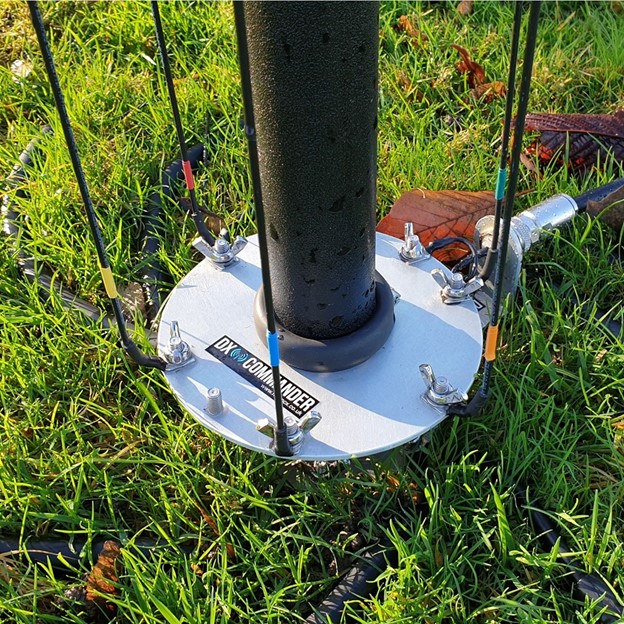For POTA and Field Day, nothing beats a telescoping fiberglass pole vertical antenna for simplicity and quick deployment. Our club’s 40 meter FD SSB antenna was up in less than 15 minutes, ready to make our first contacts.
But what about multiband versions for portable or base use? DX Commander founder and director Callum McCormick, M0MCX, came up with an interesting twist on the traditional fan dipole antenna—gathering resonant wire radiators around a telescoping pole and balancing them with a reasonably compact counterpoise.
Like other DX Commander antennas, a fiberglass telescopic mast (in this case 32.8 feet high) is the cornerstone of the DX Commander Classic HF Multiband Vertical Antenna described here. Metal and milled plastic parts help support the antenna elements, which are spaced around the mast. All antenna elements are essentially quarter-wave or 5/8th-wave verticals, all coupled into a central feedpoint. They’re kept snug with shock cord attached through several support plates.
The Build
The DX Commander Classic I tested is a lightweight, relatively easy-to-build vertical antenna that covers 2m to 40m (80m in an optional inverted L configuration). The antenna kit user guide, available online, is full of illustrations and helpful tips for reference. However, I’d highly recommend viewing Callum’s How to Build instructional video as your first introduction.

Assembly consists mostly of cutting wires to the correct length and then trimming the length afterward to achieve best match. I found the lengths recommended in the manual were very close to those we determined after tuning. Remember that the number and length of radials used will also affect tuning. Aim for more, shorter radials rather than longer ones. According to Callum, radials between 3m and 5m in length will be sufficient.
Mechanical construction involves attaching hardware and the SO-239 connector to the element and radial plates. Fork connectors need to be attached and soldered to the radials and vertical wires attached to the mast. These, in turn, are connected to the metal plates at the bottom of the antenna using bolts and wing nuts.
Slip and Slide
One characteristic common to all lightweight fiberglass poles is the inevitable slip and slide. No matter how tightly you twist the sections to lock them as you raise the mast skyward, they will sometimes slip after being raised to full height and securely guyed. That happened to us during a recent Saturday at our OSPOTA activation (the Buckeye POTA). Electrical tape around the joints didn’t provide quite enough protection.
Fortunately, a workable solution is provided with the DX Commander Classic—the stay-up kit. You’ll find nylon band-style clamps among the accessories included. These are fitted above each joint (the smaller diameter side). They’re also used to stabilize the wire plates at the bottom of the mast.
For permanent installs, you need to go a bit above and beyond the kit to do additional guying, reinforce the mast, and anchor the bottom to prevent slipping. There are several YouTube videos that show how to make bottom anchors from PVC and other materials. I’m looking forward to setting one up at our Arizona location to test how it survives winds and UV exposure over time.
Setup
Setting up the antenna for the first time was really straightforward, especially with two people. Basically, you need to mark out the zone for the three guy lines, which are attached to stakes driven into the ground. Next, you extend the pole out horizontally and add the paracord and elements. Here is where you have two options—as the pole gets longer, you can slide the spreaders onto the pole one at a time as you go, or you can just extend all the sections and friction-lock into place and then slide the spreaders on in a single pass. We opted for the latter.
In addition to the friction of the pole holding everything up, we contemplated adding the clamps, but couldn’t find the proper size nut driver. That’s something we’ll remember the next time. As I mentioned earlier, the first round of electrical tape didn’t work, so we tried a second time. Not counting the repeat setup, we figured it would take about 15-20 minutes to put up and the same to tear down, including coiling up the wire, paracord, and radials.
Final Thoughts
All in all, the DX Commander Classic HF Vertical Antenna is lightweight, solid, and covers the bands specified. It’s reasonably priced for what you get and has plenty of support courtesy of Callum’s YouTube videos. Be sure to secure the pole sections to avoid do-overs.
The complete antenna kit weighs around eight pounds complete with radial and element wires and guying, and is easily backpack-able (if you strap the pole to the outside). It’s ideal for longer-term SOTA or POTA trips, Field Day, or other times when you need more than a random wire. It operates as advertised, tunes up well, has a sufficiently wide bandwidth, and deploys and packs up quickly so you can enjoy more operating time.

